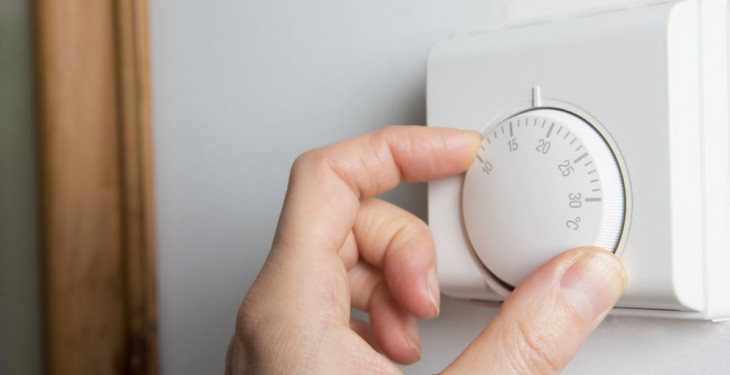
A thermostat when used effectively can be a vital part of central heating control for your home, as well as a tool to help minimise expenses.
Get a new boiler quote, save up to £550 per year (0% APR available).
In this blog we’ll be taking a look at the topic of thermostats, including what they are, how they work and how to use them.
A thermostat is a regulatory device that can sense the temperature in a specific location, i.e your home, and then can action responses to adjust or maintain conditions.
The most basic type of thermostat, the mechanical thermostat, contains a bimetallic strip that expands and contracts in accordance to temperature changes.
If the temperature drops below the desired level, the bimetallic strip contracts to switch the heating system on, doing the opposite and expanding to turn it off when the property is too hot.
Modern thermostats detect changes in temperature via electronic sensors and can be programmed to turn on and off at specific times.
On an internal wall in a room used frequently (often the living room).
Away from direct heat sources (radiators, sunlight) or cold spots (draughty areas, external walls).
Height: around chest level (≈ 1.2-1.5 m) so it reads average room temperature.
If using a smart thermostat with wireless receiver, ensure signal isn’t obstructed by solid metal walls or large appliances.
Start by setting the thermostat to the lowest temperature that still keeps you comfortable. Many UK homes aim for 18-21 °C when occupied and lower when unoccupied.
Lowering by even 1 °C can make a noticeable difference to fuel bills.
You twist a dial until you reach your desired temperature. Simple but less accurate and lacks programming features.
Allows you to set different temperatures for times of day or days of the week. Useful for regular routines.
Connects via internet, controlled by phone/app. Learns patterns, allows remote access. Ideal for flexible lifestyles.
Thermostat Type | Control / Features | Best For |
|---|---|---|
Mechanical (dial only) | Manual dial, no programming | Simple systems, low cost |
Programmable | Set temperature schedules for day/week | Homes with regular routines |
Smart (Wi-Fi enabled) | Remote control, scheduling, learning mode | Flexible occupancy, mobile users |
Small flat / simple system → Mechanical or basic programmable may suffice.
Family home with known occupancy schedule → Programmable thermostat for improved control.
Busy lifestyles / remote control desired → Smart thermostat provides convenience and potential savings.
Compatibility check: Ensure your boiler supports any smart thermostat you choose.

A smart thermostat is a device that connects your boiler and heating system to the internet, allowing you to control your heating remotely from your mobile phone or laptop.
So long as you have internet access, you can control the temperature, turn your boiler on and off and schedule it to come on when you like- all from wherever you are. Smart thermostats can come with dial or button features and are very straightforward in terms of use, for advanced settings instructions will be in the user manual or manufacturer website.
They are also capable of learning your routine and controlling your heating around it.
It's worth noting that all our best combi boilers are compatible with smart thermostats.

Benefits of upgrading to a smart thermostat
Remote access
Save energy
Save money
Remove human error
Smart thermostats offer remote access via mobile apps, which allows you to adjust the temperature settings of your home from anywhere, at any time.
This means that you can turn on the air conditioning or heat before you arrive home so that your home is at your desired temperature when you arrive. It can also be handy if you forget to turn off your heating or cooling system when you leave home.
This feature offers convenience, especially for those with busy schedules or those who travel often, and can help save energy by ensuring that your home is not being unnecessarily heated or cooled when you're not there.
One of the most significant benefits of smart thermostats is their potential for energy and cost savings.
Smart thermostats can learn your heating and cooling habits, and based on this, create a customised schedule that saves energy while keeping your home comfortable. They can also detect when you're not at home and automatically adjust the temperature to save energy. Smart thermostats can help reduce energy consumption by up to 10-15%, leading to significant cost savings on energy bills over time.
Smart thermostats help reduce human error by automating temperature control. Unlike traditional thermostats that require manual adjustments, smart thermostats can adjust the temperature based on your preferences and lifestyle.
You no longer need to worry about forgetting to adjust the thermostat when leaving for work or going to bed, as the smart thermostat will take care of it for you.
By reducing human error, smart thermostats can help improve energy efficiency, leading to cost savings on energy bills and a more comfortable home environment.
When you have a boiler installed by iHeat, provide the option of a free wireless iHeat thermostat or a smart thermostat at a slight extra cost.
Last updated: 18th October, 2025

Written by Rick Hope
Managing Director at iHeat
Rick Hope is the Managing Director and Co-Founder of iHeat, leading the company’s mission to simplify boiler and renewable installations across the UK. With a background in digital strategy and business growth.
LinkedInArticles by Rick Hope are reviewed by iHeat’s technical team to ensure accuracy and reliability.

22nd December, 2025
Based on data from over 7000 boiler installations completed by iHeat in the past 12 months...
 Read Article
Read Article

22nd December, 2025
Here’s a quick roundup of the best combi boilers for 2026.
 Read Article
Read Article

22nd December, 2025
When your old boiler breaks down and it comes time to replace it with a new one, it might...
 Read Article
Read Article
No obligation. Takes less than 60 seconds.